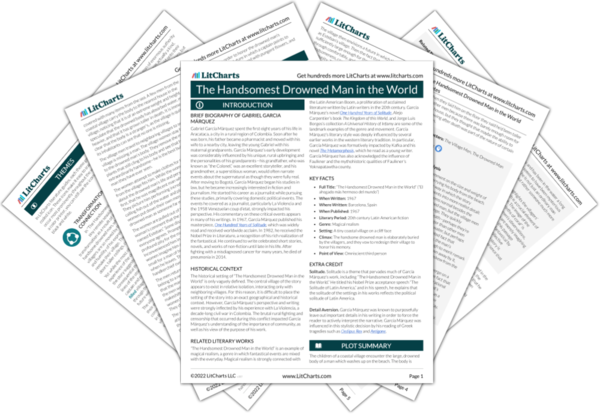When the mysterious, huge, and handsome drowned man washes up on the shores of the village in “The Handsomest Drowned Man in the World,” the question of which group the drowned man belongs to motivates much of the action in the story. When the body is first found, it is evident that he is not from the village—the tiny size of the village makes it easy for the villagers to recognize that no one who lives there is missing. This fact motivates the men of the village to go to neighboring villages to see if they might be missing a man. The men do this, presumably, out of a strong respect for kinship—for the fact that those who are related to the man will naturally care and want to know about his fate.
When the village men later return with the news that the drowned man is not from a neighboring village, the village women delight at the fact that “he is ours.” This assertion captures a difference aspect of the idea of kinship. In their time cleaning up and clothing the mysterious dead man, the woman have become attached to him—have even named him Esteban—and so when it is clear that others don’t have ties of blood kinship with the man, the woman claim kinship with him themselves. Kinship does not have to be based solely on blood ties. Yet the story suggests that when people feel kinship, they want that kinship to be socially sanctioned. And so, before the funeral for Esteban the village selects two people of the village to be his mother and father so, through the close ties of the village, everyone is his kin.
The village then envisions a future in which their village is seen as Esteban’s village. Then the fact that their homes are not sufficiently large enough for the spirit of Esteban to move through comfortably, and are not vibrant enough to honor his handsomeness, compels the villagers to transform their community. They have made Esteban their kin, and Esteban then lives on through them and their village to which he belonged. In this sense, the relation of kinship informs the most consequential change that occurs in the story. The story suggests, then, that kinship is a matter of blood, spirit, and social relations, and that the obligations and connections people feel on the basis of kinship is what often informs the most noble acts of self-improvement.
Kinship ThemeTracker

Kinship Quotes in The Handsomest Drowned Man in the World
They did not even have to clean off his face to know that the dead man was a stranger. The village was made up of only twenty-odd wooden houses that had stone courtyards with no flowers and which were spread about on the end of a desertlike cape.
At the final moment it pained them to return him to the waters as an orphan and they chose a father and mother from among the best people, and aunts and uncles and cousins, so that through him all the inhabitants of the village became kinsmen.











